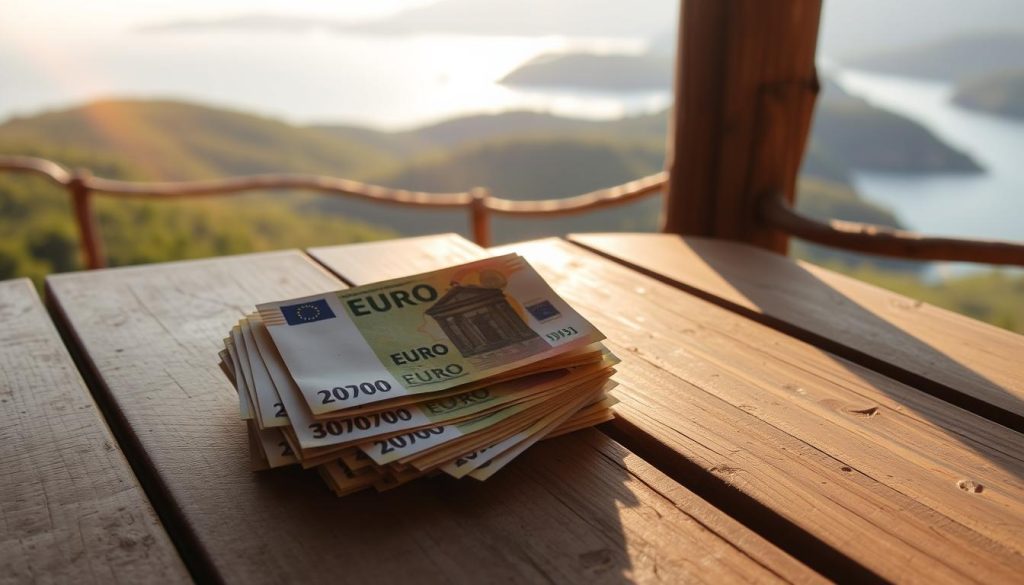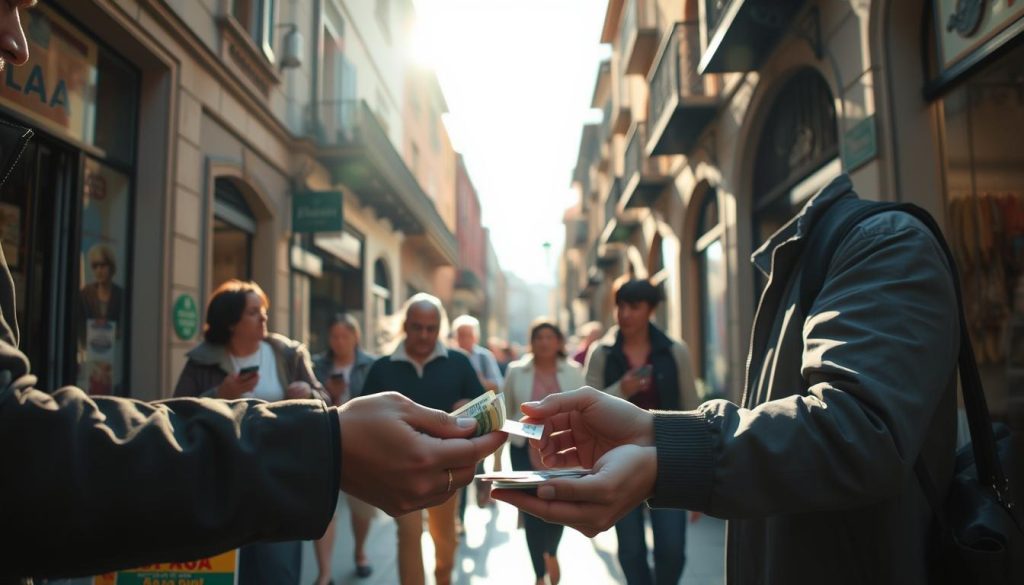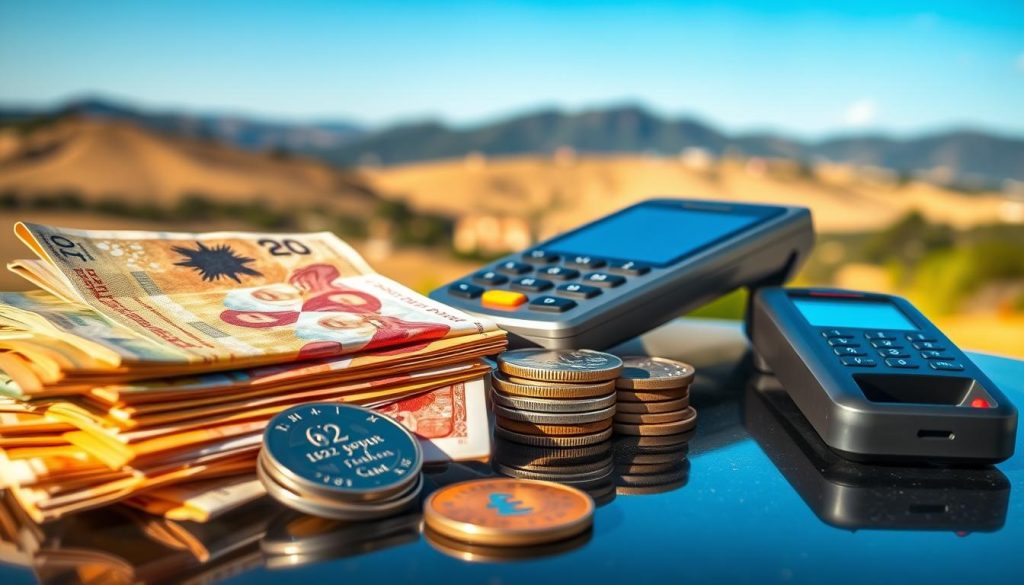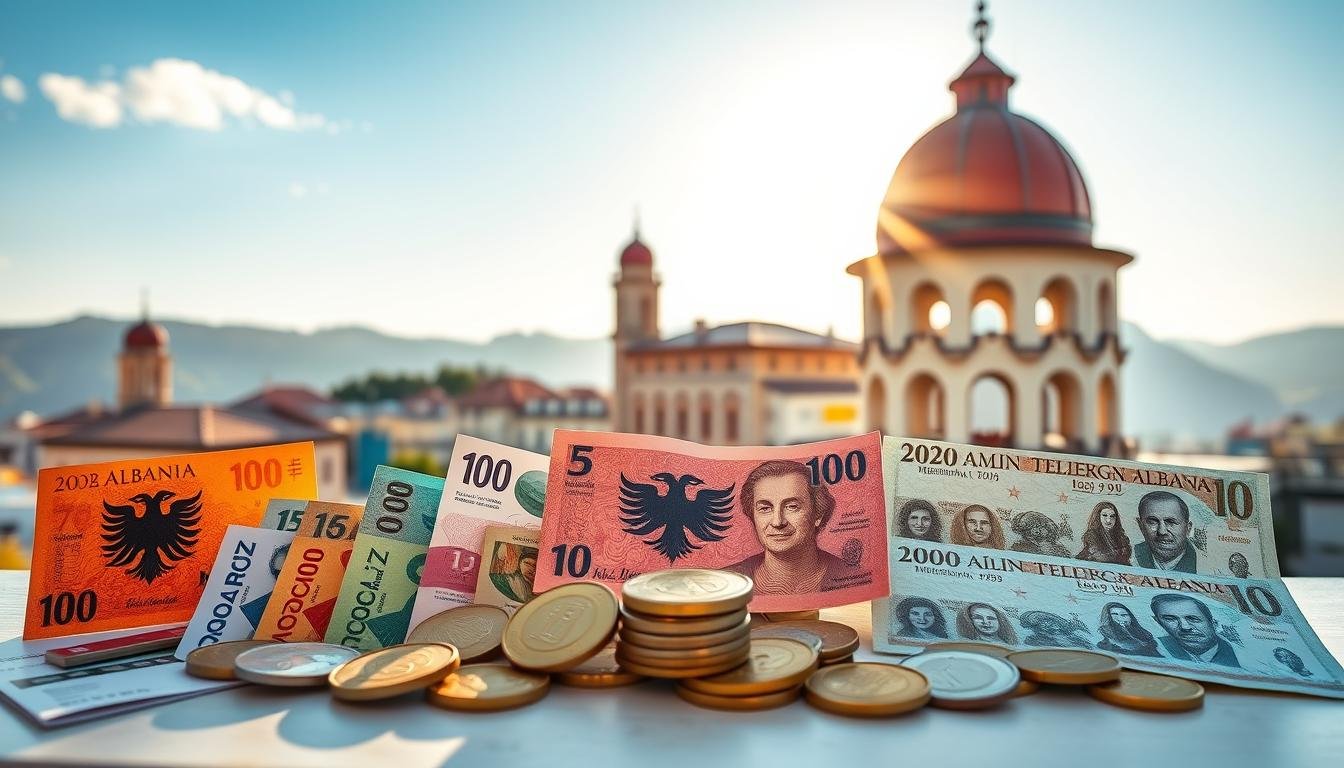✓ Accommodations✓ Flights✓ Rental Cars✓ Tours & Activities
Did you know that the Albanian lek is one of the few currencies in the world that doesn’t use a decimal system? This unique feature makes it stand out in the global financial landscape. If you’re planning a trip to this beautiful country, understanding its currency and payment practices is essential for a smooth experience.
While the lek is the official currency, euros are widely accepted in hotels and taxis, offering flexibility for travelers. This dual-currency system can be both convenient and confusing if you’re not prepared. That’s where this guide comes in—to help you navigate exchange rates, fees, and the best ways to manage your money during your stay.
From cash usage to card payments, we’ll cover everything you need to know to make your trip hassle-free. Whether you’re withdrawing from ATMs or tipping in local shops, managing your finances effectively will enhance your travel experience. Let’s dive in and explore how to make the most of your money in this fascinating country.
Understanding Albania’s Currency: The Albanian Lek
The Albanian lek has a rich history tied to the country’s cultural heritage. Named after Lekë Dukagjini, a national hero, it reflects Albania’s journey through economic reforms and modernization. Today, it’s the official currency, and understanding its nuances can make your trip smoother.
History and Denominations
Introduced in 1926, the lek has undergone significant changes. The most notable reform was in 1992, which stabilized the currency after years of economic uncertainty. Today, it’s available in both coins and banknotes, with common denominations like 100, 200, 500, and 1000 lek.
Coins are used for smaller transactions, while banknotes handle larger purchases. The design of each note showcases Albania’s cultural and historical landmarks, making them a piece of art in your wallet.
Current Exchange Parity and Value
The lek’s value is influenced by global economic trends. As of now, 1 euro equals approximately 125 lek, while 1 US dollar is around 110 lek. Here’s a quick look at current exchange rates:
| Currency | Exchange Rate (LEK) |
|---|---|
| Euro (EUR) | 125 |
| US Dollar (USD) | 110 |
| British Pound (GBP) | 140 |
You can exchange money at local banks or exchange agencies. Banks often charge a small fee, but they offer reliable rates. Exchange agencies, on the other hand, are convenient and widely available in cities.
Understanding these details ensures you’re well-prepared to manage your finances during your visit. Whether you’re shopping, dining, or exploring, knowing the lek’s value will help you make informed decisions.
Deciding Which Currency to Bring to Albania
Planning your trip? Deciding which currency to bring can save you time and money. While the local lek is the official currency, many travelers find it easier to carry euros. This choice can simplify your travel experience, especially in tourist-heavy areas.
Why Euros Are the Best Option
Euros are widely accepted in hotels, airport taxis, and exchange agencies. This makes them a convenient option for visitors. Arriving with euros can help you avoid the hassle of exchanging rare currencies abroad. It also ensures you’re prepared for immediate expenses like transportation or accommodation.

Carrying euros can also reduce extra costs. For example, using euros at local exchange agencies often results in better rates compared to other currencies. This can help you stick to your budget and avoid unnecessary fees.
Alternative Currencies for Travelers
If euros aren’t your primary currency, US dollars and British pounds are also easy to exchange. These currencies are supported at most banks and exchange offices. However, keep in mind that they may not be as widely accepted as euros for direct payments.
Choosing the right currency can significantly impact your trip. It ensures you’re ready for any situation, from dining out to shopping at local markets. Consider your needs and travel style when making this decision to enhance your overall experience in this beautiful destination.
Navigating Currency Exchange in Albania
Local exchange agencies often provide better rates than banks or airport kiosks. These agencies are widely available in cities and offer competitive exchange rates with minimal fees. Knowing where to go can save you both time and money during your trip.
Finding Local Exchange Agencies
Local exchange agencies are a traveler’s best friend. They typically charge less than 1% in margins, compared to banks that may charge up to 8%. These agencies are easy to find in city centers and near popular tourist spots.
Using your phone to check real-time exchange rates can help you identify the best place to exchange money. Apps like XE Currency provide live updates, ensuring you get the most value for your cash.
Tips to Avoid High Fees
To avoid unnecessary costs, steer clear of airport kiosks and banks. These locations often have higher fees and less favorable rates. Instead, research reputable exchange agencies before your trip.
Here’s a quick comparison of fees:
| Location | Average Fee |
|---|---|
| Local Exchange Agency | Less than 1% |
| Bank | Up to 8% |
| Airport Kiosk | 10% or more |
Always verify the rate before finalizing a transaction. This simple step ensures you’re not overpaying and helps you stick to your budget.
Avoiding Airport Currency Exchange Pitfalls
Exchanging money at the airport might seem convenient, but it’s rarely the best option. Airport kiosks often charge significantly higher fees and offer less favorable exchange rates compared to local agencies or banks. This can quickly eat into your travel budget, leaving you with less cash for your trip.

Why are airport exchanges so costly? These services rely on travelers who need immediate cash, often charging up to 15% in fees. Additionally, the exchange rate at airports is typically inflated, meaning you’ll get fewer euros or dollars for your money. For example, while the mid-market rate might be 1 USD = 0.92 EUR, airport kiosks could offer 1 USD = 0.85 EUR.
Understanding Airport Exchange Rates
Airport kiosks often use dynamic currency conversion (DCC), which can lower the value of your money by 4% to 13%. This means you’re paying more for the same amount of cash. Even restaurants within airports may use less favorable rates, so it’s wise to double-check before making purchases.
Here’s a quick comparison of fees:
| Location | Average Fee |
|---|---|
| Airport Kiosk | 10% or more |
| Local Exchange Agency | Less than 1% |
| Bank | Up to 8% |
To avoid these pitfalls, consider using your bank card for initial expenses or exchanging cash once you’re in the city. Local agencies and ATMs often provide better rates and lower fees, ensuring you get the most value for your money.
“Airport exchanges are convenient but costly. Planning ahead can save you both time and money.”
By avoiding airport exchange services, you’ll have more funds to enjoy your trip. Whether you’re dining out or shopping, every dollar saved counts. Plan wisely and make the most of your travel experience.
Using Credit and Debit Cards in Albania
Using credit and debit cards in this country can be both convenient and cost-effective if you know the right strategies. While larger hotels, international shops, and travel agencies accept cards, many local businesses prefer cash. This makes it essential to plan your payments wisely.
Card Payment Acceptance and Fees
Cards are widely accepted in tourist areas, but fees can vary. Most ATM withdrawals come with a charge of €4 to €5 per transaction. Additionally, foreign transaction fees from your bank can add up quickly. To avoid surprises, check your bank’s policies before your trip.
Here’s a quick breakdown of common fees:
- ATM withdrawal fees: €4–€5 per transaction
- Foreign transaction fees: 1%–3% of the amount
- Dynamic currency conversion fees: 4%–13%
Minimizing Foreign Transaction Charges
To reduce extra costs, consider using travel debit cards like those from Wise or Monzo. These cards offer low conversion fees and transparent rates. Withdraw larger amounts at ATM machines to limit per-transaction fees. Always monitor your phone for transaction details to avoid hidden charges.
“Using the right card can save you both time and money during your trip.”
By planning ahead and choosing the right payment methods, you can make the most of your credit and debit cards while avoiding unnecessary expenses.
Managing Cash Payments for Everyday Expenses
When exploring local markets and small shops, cash is your best friend. Many everyday vendors, bakeries, and small businesses rely solely on cash for payments. This makes it essential to carry enough money for your daily needs.

Local Practices and Cash-Only Spots
In many areas, especially outside major cities, card payments are uncommon. Local restaurants, street food vendors, and small shops often operate on a cash-only basis. This means you’ll need to plan ahead to avoid running out of cash during your day.
Here are some common scenarios where cash is essential:
- Meals at local restaurants and street food stalls
- Purchases at markets and small shops
- Public transportation and local taxis
Carrying a mix of euros and the local currency is the most practical approach. Euros are widely accepted, but exchanging some into the local currency can help you avoid extra fees and get better deals.
Why Cash is King
Using cash not only ensures smooth transactions but also allows you to negotiate prices, especially in markets. Many vendors offer discounts or better deals when you pay in cash. This can help you save money and stick to your budget.
Here’s a quick comparison of common daily expenses:
| Expense | Average Cost (in Euros) |
|---|---|
| Meal at a local restaurant | 5–10 |
| Street food | 2–5 |
| Public transport ticket | 0.50–1 |
Planning ahead ensures you have enough cash for all your daily transactions. Whether you’re dining out or shopping, being prepared enhances your experience and helps you avoid unnecessary stress.
Transportation and Currency: Paying for Travel Services
Getting around efficiently requires understanding the local payment methods for transportation. Whether you’re taking a taxi, hopping on a bus, or renting a car, knowing how to handle payments can save you time and money.
Paying for Taxis, Buses, and Car Rentals
When using a taxi, always confirm the fare before starting your ride. Many drivers in cities and at airports use meters, but it’s wise to negotiate upfront to avoid surprises. For example, a ride from Tirana Airport to the city center typically costs between 20-25 euros.
For bus travel, fares are often paid in cash. Short trips may cost as little as 100 lek (0.82 euros), while longer journeys can range up to 12 euros. Make sure you have exact change, as drivers may not carry large amounts of cash.
Renting a car is another option, but many agencies require cash payments for deposits or additional fees. Always check the cost breakdown and confirm accepted payment methods before signing any agreements.
Tips to Avoid Overpaying
To save money, avoid rush-hour surcharges by timing your trips outside peak hours. Use apps or guides to verify standard fares, ensuring you’re not overcharged. For taxi rides, apps like Taxi Albania provide real-time estimates.
Here’s a quick comparison of common transportation costs:
| Service | Average Cost |
|---|---|
| Taxi (airport to city center) | 20-25 euros |
| Bus (short trip) | 100 lek (0.82 euros) |
| Bus (long distance) | Up to 12 euros |
| Car rental (daily rate) | 30-50 euros |
By planning ahead and understanding local practices, you can navigate transportation payments with ease. Whether you’re exploring cities or venturing into the countryside, these tips will help you stay within budget.
Planning Your Budget: How Much Money to Bring
Planning your daily budget is key to enjoying a stress-free trip. Knowing how much money to bring can help you avoid overspending and ensure you’re prepared for all your needs. On average, travelers spend around €42 per person per day, but this can vary based on your travel style.
Daily Spending Estimates and Budget Tips
Here’s a breakdown of typical daily expenses to help you plan your trip:
- Meals: Expect to spend €7–€10 per day on food, depending on whether you eat at local restaurants or street vendors.
- Accommodation: Budget travelers can find hostels for €12–€16 per night, while mid-range hotels cost around €27–€30.
- Transport: Public transport is affordable, with daily costs averaging €6. Taxis and car rentals are pricier but convenient for longer trips.
- Activities: Entry fees to attractions and tours range from €5 to €15, depending on the location.
To stretch your money further, consider these tips:
- Use the local exchange rate to calculate expenses accurately. For example, 1 euro equals approximately 125 Albanian lek.
- Carry a mix of cash and cards. While cards are accepted in cities, smaller towns often prefer cash.
- Plan for unexpected costs by adding a 10% buffer to your daily budget.
Here’s a quick comparison of daily budgets for different travel styles:
| Travel Style | Average Daily Cost |
|---|---|
| Budget | €38 |
| Mid-Range | €92 |
| Luxury | €222 |
By planning ahead and tracking your costs, you can make the most of your trip without breaking the bank. Whether you’re exploring cities or relaxing by the coast, a well-planned budget ensures a smooth and enjoyable experience.
Practical Payment Methods: Combining Cash and Card
Combining cash and card payments is a smart way to handle expenses during your travels. This approach offers flexibility, ensuring you’re prepared for any situation. Whether you’re dining out, shopping, or exploring, having both options can make your trip smoother and more enjoyable.
Why Use Both Cash and Cards?
Using both cash and cards allows you to adapt to different payment scenarios. For example, local markets and small shops often prefer cash, while larger establishments accept card payments. This dual approach ensures you’re never caught off guard.
Travel debit cards, like those from Wise, are a great option. They offer low conversion fees and transparent transaction rates. This can save you money compared to traditional bank cards.
Advantages of Travel Debit Cards
Travel debit cards are designed for international use. They support multiple currencies and provide real-time exchange rates. This eliminates the need for frequent currency conversions and reduces extra fees.
Here’s a quick comparison of fees:
| Payment Method | Average Fee |
|---|---|
| Traditional Bank Card | 1%–3% |
| Travel Debit Card | Less than 1% |
| Cash Exchange | Up to 5% |
When to Use Cash vs. Cards
Use cash for small purchases, local markets, and tipping. Cards are ideal for larger expenses like hotels and car rentals. Always make sure to check transaction details on your phone to avoid hidden fees.
For example, paying with a credit card at a restaurant might incur a foreign transaction fee. In such cases, cash is the better option.
Step-by-Step Guide to Combining Payment Methods
- Carry a mix of cash and cards for flexibility.
- Use travel debit cards for low conversion fees.
- Monitor exchange rates using apps like Wise.
- Check transaction details to avoid hidden fees.
- Plan ahead for cash-only spots like markets and small shops.
By following these steps, you can streamline your expenses and make the most of your money during your trip.
Albania: Ultimate Travelers Guide to Currencies & Payments
Managing your finances effectively is crucial for a seamless travel experience. This guide has covered everything you need to know about the local currency, payment methods, and tips to avoid unnecessary fees. Whether you’re using cash or cards, planning ahead ensures you’re prepared for any situation.

Understanding the Albanian lek and its exchange rates is the first step. With 1 euro equaling approximately 125 lek, you can start budgeting for your trip. Always compare rates at local agencies to get the best deal. Avoid airport kiosks, as they often charge higher fees.
Using a mix of cash and cards is the most practical approach. While cash is essential for small purchases and local markets, cards are widely accepted in hotels and larger stores. Travel debit cards like Wise offer low conversion fees, making them a great option for international use.
Here’s a quick recap of key tips:
- Carry both euros and lek for flexibility.
- Use travel debit cards to minimize foreign transaction fees.
- Exchange money at local agencies for better rates.
- Plan your daily budget to avoid overspending.
By following these strategies, you can make the most of your money during your visit. Whether you’re exploring cities or relaxing by the coast, this guide is designed to help you manage your finances efficiently.
For more detailed advice, revisit the earlier sections of this guide. From currency exchange to transportation payments, each topic is covered to ensure a smooth and enjoyable trip. Happy travels!
Local Insights: Tips from Experienced Travelers
Traveling smart means learning from those who’ve been there before. Experienced travelers often share valuable advice that can save you time, money, and stress. Here are some insider tips to help you navigate your trip with ease.
Insider Currency Exchange Advice
One of the best tips from seasoned travelers is to avoid dynamic currency conversion (DCC). This service, often offered at airports or hotels, can add unnecessary fees. Instead, always make sure to settle transactions in the local currency.
Using your phone to monitor live exchange rates is another smart move. Apps like XE Currency provide real-time updates, helping you find the best rates. Local exchange agencies often offer better deals than banks or airport kiosks.
| Location | Average Fee |
|---|---|
| Local Exchange Agency | Less than 1% |
| Bank | Up to 8% |
| Airport Kiosk | 10% or more |
Money-Saving Strategies on Your Trip
Negotiating prices is a common practice in local markets. Don’t hesitate to ask for a better deal, especially when paying in cash. Tipping is also appreciated, with 10% being the standard at restaurants and bars.
Another tip is to use travel cards like Wise or Monzo. These cards offer low conversion fees and transparent rates, making them ideal for international use. Always make sure to check transaction details to avoid hidden charges.
“Using the right card and avoiding DCC can save you both time and money during your trip.”
Here are some additional strategies to stretch your money further:
- Withdraw larger amounts at ATM machines to limit per-transaction fees.
- Carry a mix of cash and cards for flexibility in different situations.
- Plan your daily budget to avoid overspending and unexpected costs.
By following these tips, you can make the most of your travel experience. Whether you’re exploring cities or relaxing by the coast, these insights will help you manage your finances efficiently.
Conclusion
Navigating finances during your trip doesn’t have to be stressful. With the right preparation, you can manage your money efficiently and enjoy a seamless experience. This guide has highlighted the importance of understanding local currency, using the best exchange strategies, and combining cash and card payment methods.
Planning ahead is key. Carry a mix of cash for small purchases and cards for larger expenses. Always compare exchange rates at local agencies to avoid high fees. Apps like XE Currency can help you track real-time rates, ensuring you get the best value.
By following these tips, you’ll feel confident and prepared for your trip. Whether you’re exploring cities or relaxing by the coast, managing your finances effectively will enhance your experience. Share your own tips and experiences to help future travelers make the most of their travel adventures!
The above is subject to change.
Check back often to TRAVEL.COM for the latest travel tips and deals.






